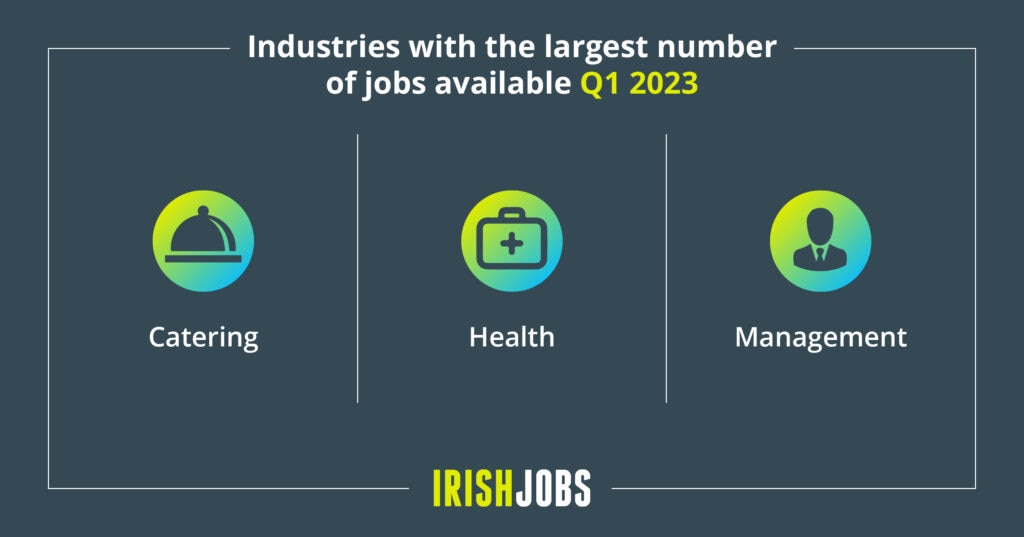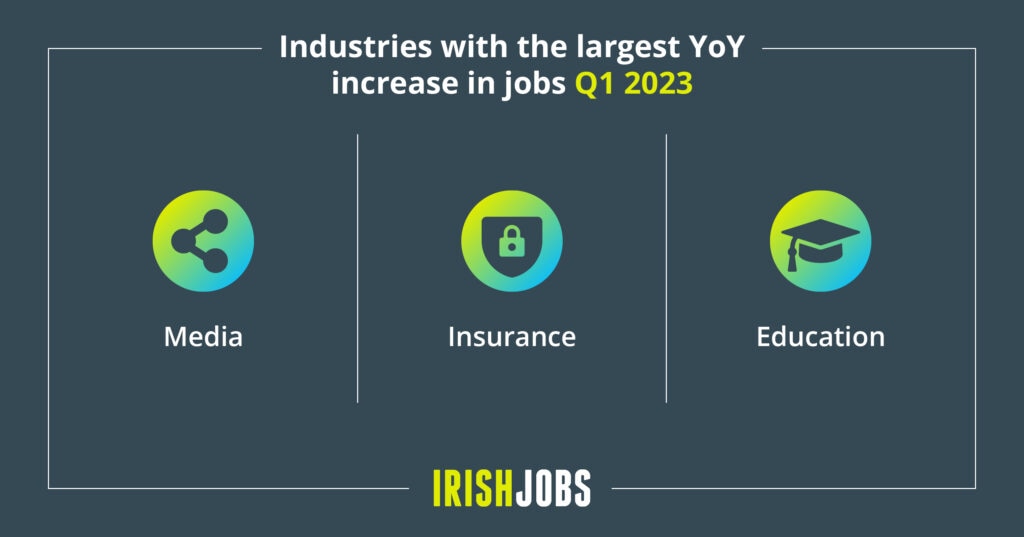Leading hiring platform IrishJobs has today published the results of its latest quarterly Jobs Index. Revealing a cooling but competitive job market, the Index shows that job vacancies fell by 20% year-on-year (Y-o-Y) and 6% quarter-on-quarter (Q-o-Q) but that jobs are still, overall, up 10% on pre-Covid levels.
Hiring sectors

Since reopening in early 2021, hospitality activities have re-emerged as the largest source of job vacancies. Although it has yet to return to pre-Covid numbers, the Catering sector – which includes a wide set of hospitality services – accounted for just under 13% of job vacancies generated in Q1 2023. The Medical Professionals & Healthcare sector (9%) was the next largest generator of job vacancies in this quarter, followed by jobs in management (8%).
Even with the current uncertainty across the technology industry, the IT sector continues to be a large source of job vacancies in the Irish economy and is the fourth largest overall, accounting for 7% of job vacancies recorded by IrishJobs data in Q1 2023.
And despite a decline in year-on-year and quarterly terms (-23% and -10%, respectively), IT jobs in this quarter also remain 21% higher than that of pre-Covid Q1 2019.

This quarter’s Job Index also highlights a number of distinct sectoral trends within the Irish jobs market that fall under the headings Normalisation, Retrenchment and Continuity.
Normalisation
Characterised by those sectors that have posted year-on-year declines in vacancy creation but have experienced quarterly vacancy growth or only modest quarterly decreases, sectors experiencing normalisation include Retail, which is down by 31% Y-o-Y and 6% Q-o-Q, Sport and Fitness, down by 25% Y-o-Y, and Catering, which is down 31% Y-o-Y and 4% Q-o-Q.
Construction-related activities also fall into this category, with Construction down 9% Y-o-Y and up 3% Q-o-Q. Meanwhile, Engineering is down 6% Y-o-Y and up 6% Q-o-Q.
Retrenchment
In contrast, a number of sectors appear to be undergoing retrenchment. Seemingly reluctant to generate additional vacancies in the face of current economic pressures, these sectors have posted vacancy declines in both year-on-year and quarterly terms for Q1 2023 and comprise internationally traded activities and multinational-intensive sectors.
Two of these sectors in particular, Sales (down 34% Y-o-Y and 22% Q-o-Q) and Manufacturing (down 35% Y-o-Y and 10% Q-o-Q) remain below their pre-Covid vacancy levels.
Two other significant sectors in the Irish market have posted both annual and quarterly decreases but remain above their pre-Covid vacancy levels: Science (down 25% Y-o-Y and 15% Q-o-Q); and Banking (down 34% Y-o-Y and 9% Q-o-Q).
Continuity
Lastly, a small number of sectors appear to have posted increases on both Y-o-Y and Q-o-Q bases. The most notable of these sectors is Travel, up 27% Y-o-Y and 71% Q-o-Q, for which there still appears to be a pent-up demand. Other sectors in this category include Legal, up 6% Y-o-Y and 8% Q-o-Q, and Insurance, up 31% Y-o-Y and 9% Q-o-Q.

Location and remote working
With regards to vacancy by location, 15 counties experienced a decrease in vacancies over the quarter, while 22 counties experienced a yearly decline. Among the four counties that saw a year-on-year increase, Co Cork saw a 9% rise.
Meanwhile, the fall in fully remote vacancies that began in the third quarter of 2022 has intensified in the first quarter of 2023. Indeed, the rate of the decrease (-12%) during the first quarter is substantially faster than that of overall vacancies. Employers in Dublin (79%) and Cork (9%) are responsible for the lion’s share of these vacancies, suggesting that homeworking in Ireland is strongly driven by the pressures of commuting into large cities.
Commentary
Sam McIlveen, Managing Director of StepStone Ireland, the parent company of IrishJobs, said:
“The IrishJobs Jobs Index is an important barometer that provides timely indicators of Irish economic activity by tracking how the jobs market is performing on a regular basis. Our latest Index shows that while job vacancies have fallen in the latest quarter, overall, the jobs market is still strong, with jobs up 10% on pre-Covid levels.
“The Index also offers the opportunity to analyse distinct sectoral trends, and it is interesting to see in this quarter how different sectors are responding to current economic conditions, with some experiencing little or no change while others are posting vacancy declines. Nevertheless, while the post-Covid exuberance of 2021 and early 2022 has now run its course, given the high employment rates we’re continuing to see across the economy, the latest figures will do little to ease the recruiting pressures for employers. The imbalance between supply and demand in the Irish labour market looks set to continue.
That’s why, in a more competitive recruitment market, it’s important that employers remain focused on honing and improving their attraction and retention strategies. Although fully remote roles are on the decline, flexibility and work-life balance are still top of the average jobseeker’s agenda. As well as ensuring their job descriptions are accurate, up-to-date and transparent, employers should continue to offer these benefits to potential employees in order to ensure they stand out in a more competitive recruitment market and can meet the evolving needs of prospective candidates within their field.”
